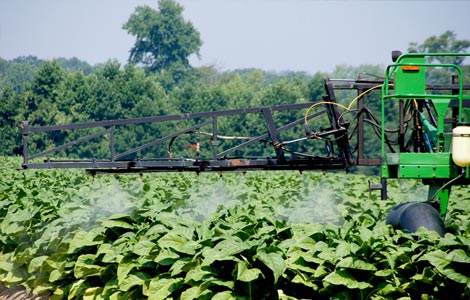
- Efficacy of some pesticides may be affected by increased pH of the pesticide tank mixes.
- Solubor® may increase the pH of unbuffered solutions.
- Inclusion of an appropriate buffer to control the pH of tank mixes is suggested for those pesticides whose efficacy is known to be reduced by increased pH.
More applicators are using foliar sprays containing 1 to 2% Solubor at the rate of 5-25 gallons per acre to increase yields and reduce foliage burn from sprays containing nitrogen and some herbicides.
Dr. Jim Woodruff, Agricultural Research Consultant at U.S. Borax, says one cost saving practice is to apply boron (B) or other nutrients together in a tank mix with insecticides, fungicides or other chemicals.
While there is no evidence that pest control is negatively affected by adding boron to the tank mix and spraying immediately, some applicators are concerned that adding boron increases solution pH to the point that some chemicals start to break down and lose efficacy.
Woodruff notes that pesticides vary in response to pH and that some are affected very little by moderate pH changes. Just how much will Solubor raise pH? “When an applicator adds Solubor at a rate of 1 lb. per five gallons of water, it will typically raise the solution‘s pH to 8.4,” says Woodruff. “This pH level might not be much higher than the pH of water in your area.”
Under high pH conditions, some pesticides may start to break down over time. But the process is so slow that most of these pesticides will remain highly effective in the tank for hours or even days. “There is no strong evidence that pest control has been adversely affected where chemicals are mixed and sprayed immediately,“ says Woodruff. “Most tank mixes are sprayed quite rapidly; aerial applications take a few minutes, and ground applications typically spray 300 gallons in less than two hours.”
Once the application is applied, Woodruff points out that most of the material is absorbed into the plant within a few hours. “There should also be no worry about pesticides breaking down once they are on the crop. Solution pH is decreased as the plant leaves absorb hydroxyl ions into the leaf apoplast, at the cellular level where the pH is buffered between 5.5 and 6.5.”
In situations where the pH of water is high, or if a particular tank mix is known to create a pH high enough to reduce a particular chemical’s effectiveness, applicators should add a buffer to the tank mix to control pH. Adding a buffer may be a good idea at marginally high pH levels if the applicator knows the tank mix may take longer than a few hours to spray out, or if rain is likely to interrupt and delay application.
“With the multitude of pesticide-fertilizer-adjuvant tank mixtures that applicators now use, it is definitely a good idea to be thinking how all these components will react with or influence each other,” says Woodruff. “With such mixtures, it‘s always necessary to conduct a ‘jar test’ first. Also, make sure that the spray equipment provides proper agitation and add products in the proper order.”